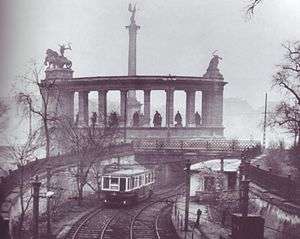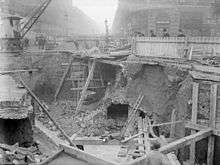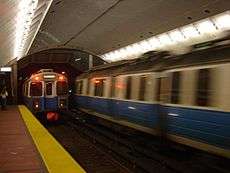History of rapid transit


Rapid transit in London began with the opening in 1863 of the Metropolitan Railway, now part of the London Underground. However, the smoke caused discomfort for passengers in operating steam trains through tunnels and limited the appeal of this mode of transport. Between 1863 and 1890 there were numerous proposals to build pneumatic or cable-hauled railways in London to overcome this problem, but none proved successful.[1] Smoke was less of a problem in steam-hauled elevated railways, starting with the West Side and Yonkers Patent Railway in New York City in 1870 (although this line opened unsuccessfully as a cable-hauled railway in 1868). The opening of London's City & South London Railway in 1890 overcame the smoke problem by using electric traction and by the First World War had led to the development of electric underground railways in Athens, Berlin, Boston, Buenos Aires, Budapest, Glasgow, Hamburg, Liverpool, New York City, Paris, and Philadelphia.
Development
First tunnels

Before any plans were made for transit systems with underground tunnels and stations, several railway operators had used tunnels for freight and passenger trains, usually to reduce the grade of the railway line. Examples include Trevithick's Tunnel from 1804, built for the Penydarren locomotive,[2] the 1829 Crown Street Tunnel at Liverpool and the 1.13 miles (1,811 metres) long 1836 Lime Street Tunnel also at Liverpool, of which a part is still used today making it the world's oldest used tunnel.
The first urban underground railway was the Metropolitan Railway, which began operations on January 10, 1863. It was built largely in shallow tunnels (see more at cut and cover) and is now part of the London Underground. It was worked by steam trains, and despite the creation of numerous vents, was unhealthy and uncomfortable for passengers and operating staff. Nevertheless, its trains were popular from the start and the Metropolitan Railway and the competing Metropolitan District Railway developed the inner circle around central London (completed in 1884) and an extensive system of suburban branches to the northwest (extending into the adjoining countryside), the west, the southwest and the east (mostly completed by 1904).
Electrification
The first electrified urban railway, London's City & South London Railway underground railway, opened in 1890, in deep tubular tunnels, leading to the term "tube", which was eventually applied to the London Underground. It was originally planned to be cable-hauled, but the bankruptcy of the company that contracted to supply the cable-haulage technology forced the railway company to consider the brand-new technology of electric traction, because its Parliamentary Act prohibited use of steam power.[3] It operated locomotive-hauled trains with three carriages, initially without windows, because it was considered that passengers would not need to know where they were if they were in tunnels.
The UK's only elevated railway opened in 1893 in Liverpool. The Liverpool Overhead Railway was the world's fourth oldest metro and was the world's first fully formed elevated railway to run electric trains from the start. The LOR pioneered Electric Multiple Units of three car trains. Automatic and electric light signals was also a first for the railway. The presence of the "El" was one aspect that earned Liverpool the nickname of "Britain's North American City".[4] The LOR was demolished in 1957 with Liverpool today served by a partially underground urban rail network known as Merseyrail.
A major breakthrough in the development of modern electrically driven rapid transit occurred when the American inventor Frank J. Sprague successfully tested his system of multiple-unit train control (MUTC) on the South Side Elevated Railroad (now part of the Chicago 'L') in 1897. MUTC, which allowed all the motors in an entire train to be dependably controlled from a single point, freed rapid transit systems from dependence on locomotive-hauled coaches.
Early systems in the West
Europe
Budapest inaugurated the first electrified underground line on the continent, the M1, in 1896. It ran from Gizella tér (now Vörösmarty tér, the city centre) to City Park and the local zoo, a distance of 3.7 kilometres (2.3 mi). It is now part of the Budapest Metro and has largely been restored to its original condition. The Budapest system was also the first electric underground railway with overhead cables rather than the more common third rail system. Car #18 is preserved at the Seashore Trolley Museum.[5]
The 10.4 kilometres (6.5 mi) Glasgow Subway in Scotland opened the same year and used cable haulage until it was electrified in 1935.
In 1898 the technically out-dated two lines of the Vienna Metropolitan Railway in Vienna was inaugurated, which was operated by steam trains. The system was transformed to a modern underground railway in 1978.

The first line of the Paris Métro opened in 1900. Its full name was the Chemin de Fer Métropolitain, a direct translation into French of London's Metropolitan Railway. The name was shortened to métro, and many other languages have since borrowed this word.
The Berlin U-Bahn (for underground railway) opened in 1902; because large sections of the line were elevated, it was also called Hochbahn (high railway) until the 1920s. Germany's second system, the Hamburg U-Bahn opened in 1904.
In 1904 the Athens-Piraeus Electric Railway, a steam-hauled suburban line built in 1869, and which acquired an underground section in the capital in 1874, was electrified throughout. It became part of the Athens Metro in 2011.
Istanbul's 1875 Tünel is sometimes described as an early subway system but is actually an underground funicular.
The Americas


Boston has the oldest subway tunnel in the United States that is still in use, part of the MBTA's Green Line downtown, dating from 1897.[6] The original construction was a short four-track tunnel, with only two stations downtown, originally built to take streetcars from outlying areas off the streets in the most congested area. In 1901-1908, heavy rail trains temporarily shared the tunnel as part of the original configuration of the Main Line Elevated, the first elevated railway in Boston. Later subway lines built in Boston carry heavy rail trains; the Green Line still operates with light rail equipment.
The New York City Subway, which has become one of the world's largest, opened its first section in 1904, a fully independent four-track line stretching 9 miles (14.5 km) from City Hall to 145th Street. Extensions were soon built, reaching the Bronx and Brooklyn; this is now part of the IRT system. Two major subway systems, operated by the BMT and the IND were constructed later, and many pre-existing elevated railway lines were incorporated into the BMT and IRT systems. The Hudson and Manhattan Railroad, which also opened a subway tunnel in Manhattan in 1908 and connected with New Jersey, remained a separate railroad company, and later came under the control of the Port Authority of New York and New Jersey as the Port Authority Trans-Hudson (PATH). Some New York City subway lines run on right-of-way first used in 1863 by railroads, and converted R44 subway cars run on the 1860 Staten Island Railway.
In 1907, the first line in Philadelphia, now part of the Market–Frankford Line, began running on both elevated and underground structures.
The oldest subway in the Southern Hemisphere, "Subterráneos de Buenos Aires", opened in 1913 originally as an underground tramway in Buenos Aires, Argentina, which is also the oldest in Latin America and the Spanish-speaking world.[7] The "Buenos Aires Underground", colloquially and officially known as Subte, and particularly Line A, with its magnificently preserved La Burgeoise wood and metal carriages, were in continuous operation for 100 years up until 2013 when they were replaced by new rolling stock.
Post-1918
Europe

The interwar period saw the first metros established at the periphery of the continent: The Madrid Metro opened on October 17, 1919 under the direction of the Compañía de Metro Alfonso XIII. Metro stations served as air raid shelters during the Spanish Civil War. Today, Madrid's subway is one of the longest systems in the world. Barcelona Metro followed in 1924.
The first underground in the USSR (in Russian метрополитен metropoliten or метро metro) opened in 1935 in Moscow. The first line — between Sokolniki and Park Kul'tury — was 11.2 km long. And the projects of two of the first stations, Krasnye Vorota and Mayakovskaya, was awarded a Grand Prix at the 1937 and 1939 World's Fairs in Paris and New York. The Moscow metro is one of the most elaborately decorated undergrounds of the world, with its stations (especially built in the Joseph Stalin epoch) often being called underground palaces. As of 2014, the Moscow metro has 325 kilometers of railways and 194 stations and is one of the busiest metro in the world. In Russia and other republics of the former Soviet Union as a whole, subways opened in Saint Petersburg (1955), Kiev (1960), Tbilisi (1966), Baku (1967), Kharkov (1975), Tashkent (1977), Yerevan (1981), Minsk (1984), Nizhniy Novgorod (1985), Novosibirsk (1986), Samara (1987), Yekaterinburg (1991), Dnipropetrovsk (1995), Kazan (2005) and currently are underfunded, slow construction in some other cities. In Volgograd and Kryvyi Rih in 1980s a "metrotram" opened – it runs underground, along with common city trams.
In 1959, a metro system was inaugurated in Lisbon, called Metropolitano de Lisboa. It was the first underground rail system in the Portuguese-speaking world.
In 1980, the second underground metro system in England, named the Tyne and Wear Metro, was opened to serve Newcastle-upon-Tyne.
After some stagnation, in the late 20th century many new European metros, some driverless and rubber-tired, appeared in medium-sized cities, especially in Spain, France and Italy.
The Americas
The Toronto Subway opened in 1954. One experimental trainset consisted of the first aluminum subway cars, which reduced weight and therefore operating costs.[8] With the next car order in 1963, only aluminum was used. The new cars, at 75 feet/23 m, were at the time the longest in the world. The Montreal Metro, was the second subway system in Canada and was inaugurated in 1966 as part of Expo 67 that would be held in Montreal.
In Brazil, the first underground opened in 1974 in nation's largest city and economical "capital" São Paulo, and now well busily carries some four million passengers on an average weekday as part of the São Paulo Metro. Part of it consists of converted older railways; some of its stations actually date from the 1880s. Underground lines have been built also in Rio de Janeiro, Belo Horizonte, Recife, Porto Alegre and capital Brasília.
Metro de Santiago is the metro system serving Santiago, the capital of the Republic of Chile. It is a network of five lines with a total of 85 stations, and the only South American rubber tired metro.
Non-capital Medellín, Colombia is served by one of the few profitable metro systems in the world. Operated by the Metro de Medellin Company, moves less than 500.000 passengers a day. This system operates in elevated infrastructure in downtown area and on-level parallel to the river. The construction of the system had astronomical cost overrun that lead to a great public debt, that still is in the budget.
Bay Area Rapid Transit (BART) in the San Francisco Bay Area and The capital's Washington Metro in Washington, D.C. opened in 1972 and 1976 respectively, as part of changing attitudes towards transportation in the United States, leading to subway and LRT systems opening in many cities that had done without.

The most recently completed fully underground heavy rail metro line in North America is the LACMTA Red Line in Los Angeles, which goes from Union Station in downtown Los Angeles, through the mid-Wilshire area, East Hollywood, central Hollywood, and ending 17 miles away in North Hollywood in the San Fernando Valley. Construction was started on this line in 1986 and completed in 2000. In autumn 2005, several politicians including Los Angeles mayor Antonio Villaraigosa indicated a desire to complete the originally conceived subway route along Wilshire Boulevard to West Los Angeles and Santa Monica. Phase One to La Cienega Blvd has been approved. http://www.metro.net/projects/westside/
Asia

Asia's first cities to have subway lines were Tokyo in 1927 and Osaka in 1933. Other major Japanese cities with subway systems are Yokohama, Sapporo, Kobe, Kyoto, Fukuoka, and Sendai.
China's first subway system, Beijing subway, began operation in 1969 only, but it was on trial operations until 1981. Tianjin (1984), Shanghai (1993), Guangzhou (1997), Wuhan (2004), Shenzhen (2004), Nanjing (2005), Dalian (2005) and many other cities also have rapid transit systems in operation.
In 1979, then British Hong Kong's subway line, the MTR, began operations. It currently has nine lines, including four that run underneath Victoria Harbour. By 1982, the British Section of the Kowloon-Canton Railway, known later as KCR East Rail and now MTR's East Rail Line, started to provide metro-like service upon electrification was completed. 2007 saw the merger of KCR into the MTR system.
India is rapidly expanding their urban rail systems as well and it is notable that the first rapid systems did not appear in the capital. India's oldest metro is in Kolkata, preceded by elevated rapid transit Chennai MRTS. The Capital, Delhi, was the third city to have a metro system. Other cities like Mumbai, Bengaluru, Chennai, Hyderabad are also constructing of metros. Recently Patna and some other cities have hired engineers and civil planners to plan the locations of future metro lines.
Since 1974, a number of cities in South Korea have also developed modern and extensive subway systems, the first lines by converting from existing heavy railway lines. The largest, Seoul, has twelve lines over approximately 314 km of track.[9] Busan, Daegu, Incheon, Daejeon and Gwangju also have subway systems. Seoul & Incheon are connected by metro.
Pyongyang in communist North Korea notably has a well adorned and deep metro with non-geographical names of stations (unique in the world) and was built to serve as a bomb shelter in case of a war.
1987 saw the opening Mass Rapid Transit in Singapore. It was the world's first heavy rail system to feature platform screen doors on its underground stations. The country made news again by having the world's first automated heavy rail system. The network has five lines with 3 more to be ready by 2030.
In 1996, Taiwan has first metro system in Taipei. Another city with a metro system is Kaohsiung (2008).
Iran built it first metro network in Tehran in 1999, the second being in Mashad, finished in 2011. Five more networks in other Persian cities are to be completed in the next years.
In Mecca, Saudi Arabia, a 20 km first line of ground and elevated metro system was completed in 2011. A total of 5 metro lines with long trains are planned to carry mass of pilgrims to the religious sites.[10] Another two similar ground metros are under construction in Riyadh (capital) and Jeddah (economical "capital").
In 2009 UAE built an elevated metro in Dubai become as one of the most modern in the world and will be followed by metros in Abu Dhabi and Sharjah.
Some other Asian countries are also constructing metro (or metro-like monorail) systems.
Africa
Cairo was the first African city with a metro system (opened 1987), which was partly converted from a railway line. It is currently under development. The second African metro was inaugurated in Algiers in November 2011. Tunis has a modern tram system that is referred to as a metro despite not being rapid transit. Pretoria, Lagos and some other African cities have plans for building a metro network.
Oceania
While most Australian capital cities have commuter rail rapid-transit services, Sydney will be the first Australian city to have a rapid transit metro network. The first section of the Sydney Metro is scheduled to open in 2019.
References
- ↑ Badsey-Ellis, Antony (2005). London's Lost Tube Schemes. Harrow: Capital Transport. p. 320. ISBN 1-85414-293-3.
- ↑ "South East Wales Historical Figures". BBC. Retrieved 2006-12-01.
- ↑ Badsey-Ellis (2005), p36
- ↑ Our lost umbrella - Liverpool Daily Post.co.uk
- ↑ http://www.trolleymuseum.org/collection/roster2.php?geo=passport&type=rapidtransit&sort=built&format=table
- ↑ "APTA 2006 Factbook" (PDF).
- ↑ "America: Subte (Subway) de Buenos Aires (Argentina)". UrbanRail.net. Retrieved 2006-11-23.
- ↑ "The Gloucester Series Cars (1954-1990)". Transit Toronto. Retrieved 2006-11-23.
- ↑ "Experiences in Seoul Subway Development" (PDF). Seoul Metropolitan Government. Retrieved 2006-11-27.
- ↑ "Makkah metro contracts signed". Railway Gazette International. June 24, 2009. Retrieved 2009-06-25.